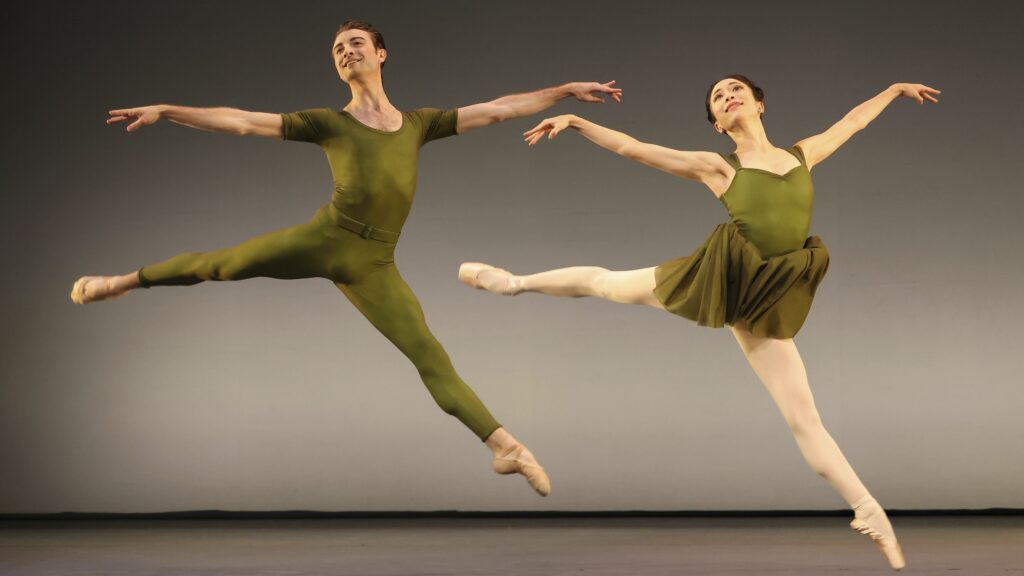A Bouquet of Ballets for the Bard
By • November 9, 2023 0 1725

On Oct. 26 to 29, the Washington Ballet showed off its versatility in a program at the Warner Theatre called “Such Sweet Thunder: An Evening Inspired by William Shakespeare.” Part of D.C.’s Shakespeare Everywhere festival, the bouquet of Bard-inspired ballets, danced to recorded music, had something for everyone.
For the story-ballet lovers, there were two exquisite pas de deux, staged by former TWB artistic director Julie Kent and former associate artistic director Victor Barbee. First was the balcony pas de deux from Kenneth MacMillan’s “Romeo and Juliet,” set to Sergei Prokofiev’s score, which premiered at the Royal Ballet in 1965. A striking and ardent Romeo at the Saturday matinee, Ariel Martinez lifted his tiny Juliet, Maki Onuki, a fluent and fluid dancer, many times with ease.
The elegant pas de deux of the fairy king and queen, Oberon and Titania, from “The Dream,” Royal Ballet Director Frederick Ashton’s 1964 one-act ballet, set to music Felix Mendelssohn wrote for “A Midsummer Night’s Dream,” came next. Though Eun Won Lee wore tiny white wings, Vladimir Tapkharov, a born leaper, spent more time aloft. Often, the two sweetly mirrored one another. The piece ended with Lee executing several splits in the kneeling Tapkharov’s arms.
For fans of avant-garde dance, there was “when shall we three meet again,” choreographed by Brett Ishida, who formed her own Texas-based company, ISHIDA, in 2019. The work’s subtitle: “a case study of three aunts, three muses.”
Riffing on the weird sisters of “Macbeth,” Ishida’s piece featured three black-clad dancers — Samara Rittinger, Noura Sander and Catherine Doherty, a member of TWB’s Studio Company — with bare arms and shoulders, thrusting their legs through slits in their long dresses. Echoing Martha Graham, the trio stretched, kicked, writhed and crouched on the dark stage to various lighting effects and jarring music by contemporary composers Scanner, Einojuhani Rautavaara and Mieczyslaw Weinberg. In a program note, Ishida referred to the “friction and drama” between sisters, concluding (as the dance does): “However, when an exterior force threatens the tribe, each sister has the other’s back.”
Finally, for those attuned to neoclassical ballet, the genre pioneered at New York City Ballet by George Balanchine — which combines traditional steps with elements of folk, jazz and modern dance, setting them to music ranging from Baroque to pop — the performance began and ended with suites by choreographer (and former NYCB dancer) Silas Farley.
The opening work was “Dowland Dances,” set to eight tracks from Sting’s 2006 album “Songs from the Labyrinth,” on which he and lutenist Edin Karamazov perform pieces by John Dowland, a contemporary of Shakespeare. Ten men and women performed, dressed in pea green, with the exception of one or two women in white, in a charming series of solos, duets and ensemble dances. The choreography’s inventiveness held one’s interest, though without a set — the backdrop was lit in different solid colors — the Warner stage sometimes felt overly large for the action.

Samara Rittinger, Catherine Doherty and Noura Sander in “when shall we three meet again.” Photo by xmbphotography. Courtesy The Washington Ballet.
The closing work, a world premiere, was Farley’s “Such Sweet Thunder,” set to music composed by Duke Ellington and Billy Strayhorn in 1957. (April 29, 2024, is the 125th anniversary of the birth of Ellington, who was born and raised in Washington, D.C.) The title comes from the line “So musical a discord, such sweet thunder,” spoken by Hippolyta, queen of the Amazons, in “A Midsummer Night’s Dream.”
In 1956, after his orchestra performed at the Stratford Shakespearean Festival in Ontario, Canada (now simply called Stratford Festival), Ellington decided to pay musical tribute to the Bard by writing a set of pieces inspired by some of the plays’ main characters. He called four of the 12 pieces “sonnets,” as in “Sonnet to Hank Cinq” for Henry V, structuring them in 14 lines as Shakespeare did his poems.
“Such Sweet Thunder” is classic Ellington and Strayhorn — bold, sexy, harmonically surprising big-band music, with Ellington’s distinctive piano interludes and phenomenal solos by the orchestra’s star brass and sax players. For his 10-part suite, Farley dropped three of the 12 sections, revised the order somewhat and added “The Single Petal of a Rose,” from Ellington’s “The Queen’s Suite” of 1958.
The musical links to Shakespeare’s characters can be hard to discern; in some cases, pieces written earlier were repurposed. For instance, “Half the Fun,” the Cleopatra number, was originally a piece called “Lately” that had nothing to do with the Egyptian queen. With its “exotic” drum beat, however, it works nicely. Farley’s Cleopatra was Ashley Murphy-Wilson, who entered held high by two male dancers. She then danced a pas de deux in front of three attendant groups of three dancers. Another highlight was “Sonnet in Search of a Moor,” in which Ariel Martinez danced to the piece’s slow pizzicato bass melody, a red-lit backdrop behind.
With a richer musical canvas than that of “Dowland Dances,” and using more of the 25-member company — at least 20 dancers were onstage at some points — Farley’s choreography for “Such Sweet Thunder,” with many jazzy touches (sometimes recalling the Jerome Robbins of “West Side Story”), had no problem “holding the stage.” One hopes that both he and Ishida will continue to have their works, so different in character, performed by TWB.

